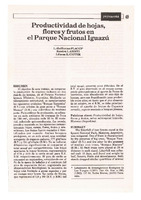Productividad de hojas, flores y frutos en el Parque Nacional Iguazú
Date
1994-09-01Author
Placci, Luis Guillermo
Ciotek, Liliana E.
Arditi, Sandra Inés
Metadata
Show full item recordAbstract
El objetivo de este trabajo, es comparar la producción de órganos caducos en dos stands de bosque, en el Parque Nacional Iguazú, Misiones, Argentina. Mediante un relevamiento estructural, se caracterizaron las siguientes unidades: "Bosque Yacaratia" (B.Y.) con árboles de gran porte y "Bosque Macuco" (B.M.) con individuos de mediano porte. Para estimar la producción, se colocaron en cada ambiente 50 trampas de fruta de 790 cm2, ubicados cada 25 m. El material, colectado quincenalmente, fue secado, pesado y separado en los siguientes compartimentos: hojas, ramas, flores, frutos y misceláneas. Los frutos fueron contados e identificados por especie. Ambos bosques produjeron, en un ciclo anual, una cantidad semejante de órganos caducos; 777 g/m2/año (B.Y.) y 731 g/m2/afio (B.M.). No se hallaron diferencias significativas al comparar el total anual por compartimento. Las hojas aportaron la mayor biomasa, representando el 67% y 70% de la caída anual para B.Y.B.M. respectivamente. El pico de caída se concentró en septiembre, coincidiendo con el fin de la época de heladas y el comienzo del pico de expansión foliar, registrado por observaciones fenológicas; la ausencia de hojas está limitada a pocas especies y por un tiempo muy breve. La caída de frutos, que representó el 2,8 y 3% (B.Y. y B.M.) del total anual, presentó picos diferidos. En el B.Y. el pico observado en el verano corresponde principalmente al aporte de frutos de lauráceas, más abundantes en este tipo de bosque, pero con fructificación poco predecible entre años; en tanto que el pico observado en octubre, en el B.M., se debe principalmente al aporte de frutos de Cupania vernalis, especie asociada a bosques jóvenes. The litterfall of two forests stand in the Iguazú National Park, Misiones, Argentina, was compared. One of them is characterized by the presence of big trees, "Bosque Yacaratia" (B.Y.); and the other by the presence of median size trees, "Bosque Macuco" (B.M.). 50 fruit traps were placed at 25 m distance in each stand. Litterfall was collected each 15 days, and dryed and weight by leaf, flowers, fruits and miscellaneous. Both stands dropped similar quantities of annual litterfall: 777 g/m2 (B.Y.) and 731 g/m2 (B.M.). Leaf-fall represented 67% and 70% of total annual litterfall for B.Y. and B.M. respectively, with a higher peak in september, at the end of frost season and the beginning of leaf flush. The absence of leaf is reduced to a few species and for a short period of time. Fruit-fall represented 3% of the annual total in both stands but with different peaks of production if dry and fleshy fruit are considered separately. Fleshy fruit production was similar in the two stands (10 g/m2/year) but shows differences in the interannual fluctuation due to the specific composition. So, the coexistence of forest patches with different production patterns, reduces fruit scarcity period for frugivores.
Collections
- Revista Yvyraretá [360]
The following license files are associated with this item:




